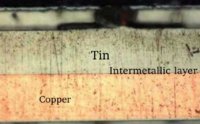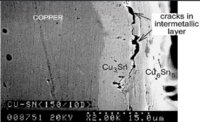Grounds, an often ignored area, can cause the most bizarre of problems. 'Floating grounds', 'Ground loops', 'Intermittant grounds', 'Ground level voltages', 'Multi-point grounds', and 'Single-point grounds' are terms you'll hear in electronics bantering, especially where high currents share the same space as sensitive semiconductors.
Every conductor has some degree of electrical resistance, even a 1mm length of thick/solid silver wire.
With this in mind, consider that no matter how good your ground connections and wiring, the 'only' place that has the 'true' ground voltage is your battery's (-) negative terminal. Everywhere else in the grounding system will have some amount of voltage, increasing as the current increases. It's like being on a municipal sewer system. Enuff folks flush their toilets all at once, and here it comes up in your home.
Power supply and high-end audio engineers take this into account, and generally apply 'single-point grounding' in their designs, where all the various ground returns are independantly tied to a single spot, at or near the 'true' ground. That way, current dumps from one section won't jack with the ground-level voltage of another section.
Our older bikes, with their stable-voltage batteries, point and coil ignitions, mechanical regulators, and incandescent lighting, are quite tolerant of casual grounding. Has to get pretty bad before these start complaining.
Put modern semiconductor devices on these things, and the rules get tightened up. Although superior, single-point grounding doesn't have to be used everywhere, but consideration must be given to the ground return path of high current devices, like the electrical starter.
The electric starter grounds thru its case, which is grounded to the bottom engine case thru its mount platform and bolts. So far, so good.
Suppose, for example, that the only reliable ground for the engine is thru the top motor mount, thru that short grounding pigtail. Not good. But it can be worse. The grounding path from the lower case to the top camcover (and its mount bosses) is best thru the cylinder studs. Can't really pass much current to the cylinder, there's a base gasket in the way. And, the head is somewhat isolated by the headgasket, some conductivity provided by the fire rings and 3 headbolts. With high currents, the ground potentials at various parts of the engine are now different.
Now consider an electronic ignition system, depending on its mounting in the cam endcover for its ground. During application of high starter currents, that cam endcover won't be at 'true' ground, and whatever voltage present at that point will be seeking ground as well, possibly trying to go backwards thru the device's semiconductors, onward thru the wiring.
It's not so much that this particular hypothetical scenario is important. What's important is the 'thinking' when designing ground return paths. For each ground, consider the serpentine path that must be taken for the return current, where are the weak points, will something else have to carry part of that current. And, don't assume something is grounded just because it's metal.
There's numerous ground fault/float/loop stories out there that make great object lessons.
One of my favorites was the mysterious chain of failures in certain automotive rear-end differentials. The rear axles had a short life, preceeded by the typical pinion/drive gear 'howling'. Drove the mechanics, and the warranty departments nuts.
It was found that these particular vehicles didn't have the complete 3-point grounding system: Battery to engine to frame. The ungrounded frame would have the frame ground currents seeking ground thru the only path available to them: Thru the rear suspension, to the axle housing, thru the axle bearings and pinion/ring gear, up thru the driveshaft, to the engine. Those ground currents were micro-welding the axle's differential parts.
There's many more stories. Maybe you've heard some as well...
Every conductor has some degree of electrical resistance, even a 1mm length of thick/solid silver wire.
With this in mind, consider that no matter how good your ground connections and wiring, the 'only' place that has the 'true' ground voltage is your battery's (-) negative terminal. Everywhere else in the grounding system will have some amount of voltage, increasing as the current increases. It's like being on a municipal sewer system. Enuff folks flush their toilets all at once, and here it comes up in your home.
Power supply and high-end audio engineers take this into account, and generally apply 'single-point grounding' in their designs, where all the various ground returns are independantly tied to a single spot, at or near the 'true' ground. That way, current dumps from one section won't jack with the ground-level voltage of another section.
Our older bikes, with their stable-voltage batteries, point and coil ignitions, mechanical regulators, and incandescent lighting, are quite tolerant of casual grounding. Has to get pretty bad before these start complaining.
Put modern semiconductor devices on these things, and the rules get tightened up. Although superior, single-point grounding doesn't have to be used everywhere, but consideration must be given to the ground return path of high current devices, like the electrical starter.
The electric starter grounds thru its case, which is grounded to the bottom engine case thru its mount platform and bolts. So far, so good.
Suppose, for example, that the only reliable ground for the engine is thru the top motor mount, thru that short grounding pigtail. Not good. But it can be worse. The grounding path from the lower case to the top camcover (and its mount bosses) is best thru the cylinder studs. Can't really pass much current to the cylinder, there's a base gasket in the way. And, the head is somewhat isolated by the headgasket, some conductivity provided by the fire rings and 3 headbolts. With high currents, the ground potentials at various parts of the engine are now different.
Now consider an electronic ignition system, depending on its mounting in the cam endcover for its ground. During application of high starter currents, that cam endcover won't be at 'true' ground, and whatever voltage present at that point will be seeking ground as well, possibly trying to go backwards thru the device's semiconductors, onward thru the wiring.
It's not so much that this particular hypothetical scenario is important. What's important is the 'thinking' when designing ground return paths. For each ground, consider the serpentine path that must be taken for the return current, where are the weak points, will something else have to carry part of that current. And, don't assume something is grounded just because it's metal.
There's numerous ground fault/float/loop stories out there that make great object lessons.
One of my favorites was the mysterious chain of failures in certain automotive rear-end differentials. The rear axles had a short life, preceeded by the typical pinion/drive gear 'howling'. Drove the mechanics, and the warranty departments nuts.
It was found that these particular vehicles didn't have the complete 3-point grounding system: Battery to engine to frame. The ungrounded frame would have the frame ground currents seeking ground thru the only path available to them: Thru the rear suspension, to the axle housing, thru the axle bearings and pinion/ring gear, up thru the driveshaft, to the engine. Those ground currents were micro-welding the axle's differential parts.
There's many more stories. Maybe you've heard some as well...









 ) The fix: replace the terminals and the plastic connector housing.
) The fix: replace the terminals and the plastic connector housing.